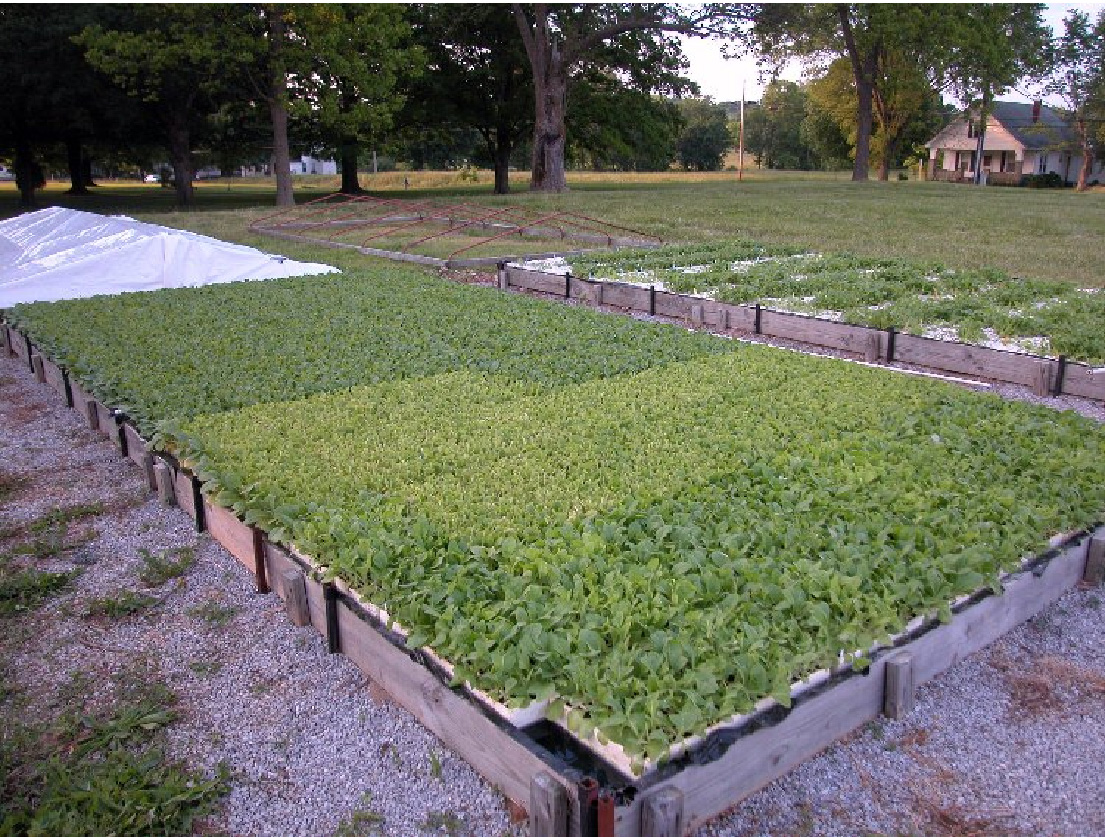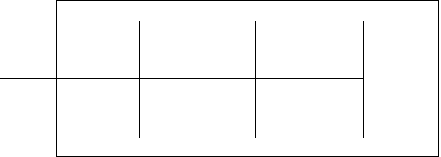PLANT & SOIL SCIENCES FACT SHEET TOB-5-07
![]()
 |
Tobacco
|
 |
Float bed and tray sterilization: Start clean and finish clean
Prior to laying new plastic for float beds, remove any debris and consider sanitizing all surface spaces in greenhouses with a disinfectant containing quaternary ammonia at 1-3 tsp/gal such as Physan 20, Green-Shield, or Quatro (read label of specific product used). Spray the prepared solution on all hard surfaces including walkways, boards, mowers and walls (2 feet or so up end walls and side curtains). Do not use bleach on metal greenhouse components as this could hasten corrosion. Using new trays (regular or disposable) is best, but if old trays are used, sanitize trays by steaming (30 minutes at 140 to 160o F) or wash with 10% bleach solution. If sanitizing with bleach, wash trays, brush outer surface and coat all cells with bleach solution. If dipping trays, change the bleach solution regularly, every 30 to 60 minutes or when solution becomes heavily contaminated with soil, to keep chlorine levels high enough to sanitize effectively. Allow trays to dry before filling with media. Trays may be wrapped in plastic overnight to improve the action of the bleach treatment.
Media: check soil moisture and wicking before seeding
To make sure media is fresh and will wick moisture quickly, fill a few trays with media, dibble, and float them to see how long it takes moisture to reach the top of the tray. Keep in mind that media will wick more quickly on cloudy days than on sunny days due to evaporation. On cloudy days, fresh media should wick moisture to the top of trays within minutes of floating. On sunny days, even fresh media may take from 15 minutes to 1 or even 2 hours to wick. Check media wicking on a few trays before seeding the entire bed. Over packed trays may tend to wick more slowly than properly filled trays. Moisture levels in the media affect wicking potential and a quick check can indicate the status of the media. Pick up a hand full of media and squeeze. Media with adequate moisture should retain its shape when released, but break apart when touched. High moisture media will retain the squeezed shape and will not readily break apart. Low moisture media will break apart once released. Wicking of leftover or dry media can be improved somewhat by adding ½ to 1 gallon of water per bag 1 or 2 days prior to tray filling. Use moisture check method above to determine final moisture after allowing media to equalize.
Water level in beds: 3 to 5 inches
Keeping the initial water volume at a level where the tray surface is below the side of the bed may provide some protection from cold breezes during germination. Raising the water level once the plants have developed sufficient foliage allows more air flow through plants and makes conditions less conducive to foliar diseases. This generally requires 3 to 5 inches of water depending on bed depth. A lower volume of water will also reduce the amount of certain fungicides needed to achieve the recommended concentration for control of water borne diseases like Pythium root rot.
Temperature: 72°, prevent drastic changes
For optimum germination and growth, temperatures at the top of the trays should be kept around 72 F (70 to 75 F) during the day and 60 to 70 during the night. After plants reach the 4-leaf stage, nighttime temperatures can be lowered to 50 to 65 F to conserve heating costs. Research at North Carolina State University has indicated a favorable growth response when the temperature is lowered at night while maintaining a favorable day time temperature.
Fertilization: 100 ppm nitrogen
You do not need to apply fertilizer to float water until seeds germinate, which is usually 5 to 10 days after seeding. Fertilizer added at seeding introduces a risk of soluble salt injury, increases algae growth, and is somewhat inefficient since plants don't really use the nutrients until they germinate and begin rooting. Nitrogen levels need to be maintained at or near 100 ppm N for the first 6 weeks or so after seeding. Nitrogen levels can be dropped to 75 ppm for the last 2 weeks prior to transplanting in order to "toughen" plants before going to the field. If nitrogen levels are allowed to drop below 50 ppm for an extended period, problems with target spot may occur. On the other hand, black leg (bacterial soft rot) is favored by nitrogen levels that routinely exceed 125-150 ppm.
For 100 ppm N, apply 4.2 lbs of 20-10-20 per 1000 gallons float water
or 5.6 Ibs of 15-5-15 (Cal Mag) per 1000 gallons float water.
To calculate the number of gallons of water in a float bed, calculate the cubic feet of the bed and multiply this by 7.48 to convert to gallons:
Bed length (ft.) X Bed width (ft.) X water depth (ft.) X 7.48 = gallons in bed
A simpler method of determining the amount of water in beds is:
Number of trays X depth of water in inches X 1.64
Example: 200 trays X water 4 inches
deep X 1.64 = 1312 gallons
4.2 lbs
20-10-20/1000 gal X 1.312 = 5.51 lbs 20-10-20
If fertilizer will be added after seeding, even distribution is essential. The best way to get even distribution of fertilizer into a float bed is to use an injection system, which can be a simple branching pipe system using ¾ inch pvc pipe in the bottom of the bed with an intake into the bed.
Float Bed
|
intake |
 |
Branching PVC piping system
Drill small holes every 3 ft. or so in piping and sink to bottom of bed. Mix fertilizer in clean, sterilized trash can or other container and pump into bed with sump pump connected to piping system coupler.
Monitoring nitrogen levels
After applying fertilizer, let settle for 24 hours before checking fertility level with a calibrated Dist 4 meter. Conductivity meters like the Dist 4 measure salt content in the water. Although these meters do not measure nitrogen directly, we can get a good idea of nitrogen levels by comparing readings from plain (unfertilized) water to that of fertilized water. Most water in Kentucky will give a reading of 0.10 to 0.40 mS on the Dist 4 meter. For 100 ppm N using 20-10-20 or 15-5-15 fertilizer, the Dist 4 reading should read 0.65 after the plain water reading is subtracted from the fertilized water reading.
Example: Dist 4 plain water reading = 0.35,
Dist 4 fertilized water reading = 1.0
Fertilized water - plain water = 1.0 - 0.35 = 0.65 (100 ppm N)
If final reading (fertilized - plain water) is greater than 0.65, add water to bed to dilute concentration and re-measure after 24 hours. If final reading is less than 0.65, add fertilizer to strengthen concentration and re-measure after 24 hours.
Nitrogen levels that approach 150 ppm increase the risk of developing the disease black leg (bacterial soft rot). Concentrations that start out normal at 100 ppm may increase to 150 ppm as transpiration and evaporation remove water from the beds at a quicker pace than the plants use the fertilization. Low fertility may increase the incidence of the disease target spot. This can be more of a problem in outside beds where rainy periods dilute the fertility in the beds. Initial plain water readings above 0.9 indicate water that is not suitable for use in the float system due to high salt content. Sulfur water tends to run high, but may be within the acceptable level.
Standard Fungicides for Float Beds:
Terramaster 4EC: prevention of Pythium root rot
Add 1 fl oz Terramaster 4EC per 100 gallons float water as a preventative treatment when roots first enter the water (usually about 3 weeks after seeding). Inject directly into float water using injection system previously described. If needed, a second Terramaster 4EC application at 1 fl oz per 100 gallons can be made at 6 weeks after seeding, and a third application at 0.8 fl oz per 100 gallons can be made at 8 weeks after seeding. Monitor root growth daily to look for signs of Pythium (slimy, dark colored roots) to determine if subsequent Terramaster applications are needed – do not apply more than 2.8 fl oz per season and do not apply later than 8 weeks after seeding. Consult current Terramaster 4EC label for specific instructions.
Dithane DF: control of target spot, Rhizoctonia damping off, sore shin, anthracnose
Apply Dithane as foliar spray at 1 teaspoon per gallon using 3 to 12 gallons of solution per 1000 square foot (about 400 trays). Begin applications before disease begins, or when symptoms are first observed at the very latest. Do not apply until plants are at least the size of a dime (approximately 2 weeks after seeding). Apply every 5 to 7 days until transplanting. Consult current Dithane DF label for specific instructions.
Clipping:
Clipping plants increases uniformity, stem diameter, and air flow through plants. Improved airflow will help in the management of diseases like black leg, target spot, and Sclerotinia collar rot. Clip regularly (3 to 5 times) before transplanting. Begin when plants are 2 to 3 inches tall and remove about 1/2 inch to 1 inch of foliage at each clipping. Removing more than 1 inch at a time may slow plant growth. Clipping into the bud may cause plants to develop suckers or multiple shoots and may render the plants unusable.
Transplant Development:
Transplants generally take 8 weeks from seeding to reach appropriate transplant size when seeded early, but they may be ready in as little 6 weeks toward the end of the season due to more favorable weather conditions late. Low fertility and disease incidence may slow growth and delay maturity beyond the 8 week period.
![]()
![]()